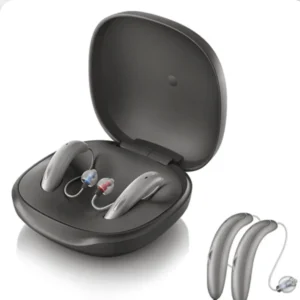Getting the Most for Your Money: Less Expensive Hearing Aids That Work
Exploring less expensive hearing aids unlocks a world where quality meets value. Here, we guide you through finding hearing aids that won’t break the bank.
A Look at Your Options
Low-End Models: Ideal for newcomers or those with mild hearing loss, these focus on basic enhancement. They lack fancy features but offer a solid start.
Mid-Range Options: These are the sweet spot for moderate hearing loss, combining essential features with affordability. They’re the choice for value-seekers.
High-End Solutions: These solutions are packed with the latest tech and suit severe hearing loss. Features like smartphone integration make them the premium choice.

Understanding the Price Tag
When it comes to hearing aids, the price tag often reflects several vital factors. Understanding these can help you navigate your options more effectively and make an informed decision that balances cost with your hearing needs.
-
Advanced Features and Technology:
The more sophisticated a hearing aid, the higher the cost. Features like wireless connectivity, advanced noise cancellation, and the ability to adapt to different listening environments are significant price drivers. These technologies enhance the user experience by offering more precise sound quality, easier integration with daily devices, and more personalized settings. However, they require more complex engineering and software, increasing the price.
-
Design and Form Factor:
The style of hearing aid significantly impacts its price. Behind-the-ear (BTE) models tend to be less expensive because their larger size can more cost-effectively accommodate technology. In contrast, In-the-Ear (ITE), Completely in-Canal (CIC), and Invisible-in-Canal (IIC) models demand advanced miniaturization technology to fit all the necessary components into a much smaller space, making them more discreet but also pricier. The cost increases with the level of discretion and the complexity of the design.
-
Material and Build Quality:
The choice of materials also plays a crucial role in determining the cost. Durable, lightweight materials that offer comfort for daily wear and longevity tend to be more expensive. These materials can withstand regular use and maintain their integrity over time, ensuring that your investment lasts longer.
-
Research and Development (R&D):
The cost of innovation is another significant factor. The research and development involved in bringing new features to market, ensuring reliability, and meeting user needs are extensive. This ongoing investment in innovation not only contributes to the initial cost of hearing aids but also ensures that users have access to the latest advancements in hearing technology.
-
Regulatory Compliance:
Hearing aids are medical devices and must meet strict regulatory standards to ensure safety and efficacy. Achieving and maintaining compliance involves rigorous testing and quality control measures, which can add to the manufacturing costs. These regulations are in place to protect users, but they also require manufacturers to invest heavily in compliance, which can influence the final price of the product.
Understanding these components helps demystify the cost associated with hearing aids and underscores the value behind the investment. While the initial price might seem high, the benefits of advanced technology, superior design and materials, and regulatory compliance assurance significantly enhance the overall hearing aid experience, offering better hearing outcomes and a more satisfying quality of life.
Choosing Wisely
Opting for pricier aids upfront can be more cost-effective in the long term. Here’s why:
- Durability and Features: Superior materials and features mean fewer replacements and upgrades.
- Professional Care: Custom fittings and regular maintenance checkups ensure optimal performance, extending your hearing aid’s lifespan.
- Overall Well-being: Clearer conversations and ease of use improve your quality of life.
Understand more about hearing aid repairs.

Finding Less Expensive Hearing Aids
Securing less expensive hearing aids that meet your needs without compromising quality involves strategic steps. Here’s how to approach finding an affordable hearing solution effectively:
-
Maximize Insurance Benefits:
Thoroughly understand the hearing aid coverage under your insurance plan. Policies differ significantly, so knowing what part of your insurance cost will cover, including any deductibles and copays, is crucial. Reach out to your insurance provider or consult with a hearing center that has insurance specialists on staff. They can help decipher the details of your coverage, potentially unlocking benefits you weren’t aware of.
-
Choose In-Network Providers:
Utilizing providers within your insurance network can lead to substantial savings. These providers have agreed to lower rates with your insurance company, meaning your out-of-pocket expenses could be significantly reduced. Always confirm a hearing center’s network status before making appointments to ensure you’re getting the best possible rate.
-
Explore Mid-Range Devices:
For many users, mid-range hearing aids strike an ideal balance between cost and functionality. These devices typically include key features that can significantly improve your hearing experience, such as noise reduction and basic programmability, without the premium price tag of high-end models. Discuss with your audiologist the possibility of a mid-range device that fits both your hearing needs and your budget.
-
Ask About Discounts and Special Offers:
Don’t hesitate to inquire about available discounts. Some hearing centers offer price reductions for seniors, veterans or through other special programs. Additionally, package deals or promotions might be available, providing more value for the same price.
-
Check Manufacturer Offers:
Hearing aid manufacturers occasionally offer rebates, financing options, or assistance programs to make their devices more accessible. These offers can significantly reduce out-of-pocket expenses. Research or ask your audiologist about any current promotions or programs you might qualify for.
-
Utilize Payment Plans:
Some hearing centers offer financing or payment plans that allow you to spread the cost of your hearing aids over time. This can make the investment more manageable by breaking it into smaller, more affordable payments.
By taking these steps, you can find hearing aids that fit your budget without sacrificing the quality of your hearing solution. It’s about being informed, asking the right questions, and exploring all the avenues available to reduce costs while still obtaining the hearing support you need.
Professional Guidance is Key
A licensed hearing care provider assesses your needs, offering options across the spectrum and ensuring you find great value. They highlight long-term advantages, sometimes recommending a slightly higher initial spend for more significant long-term value.
Find out more about choosing the best audiologist near me.
Securing Quality Sound Affordably
Even in budget models, prioritize features like noise reduction and directionality for clear listening. Realistic expectations, trial periods, and prioritizing speech clarity are crucial. Regular adjustments keep them performing well.
Striking the Balance With Less Expensive Hearing Aids
Choosing less expensive hearing aids smartly means enjoying quality sound without undue expense. Features like noise reduction and directional microphones, coupled with expert advice, ensure you find the right balance between cost and quality. Quality care, rather than just the price, dictates the actual value of your hearing aids.
Contact Stanford Hearing today for a consultation on affordable hearing solutions. Together, we can enhance your hearing without straining your budget.
